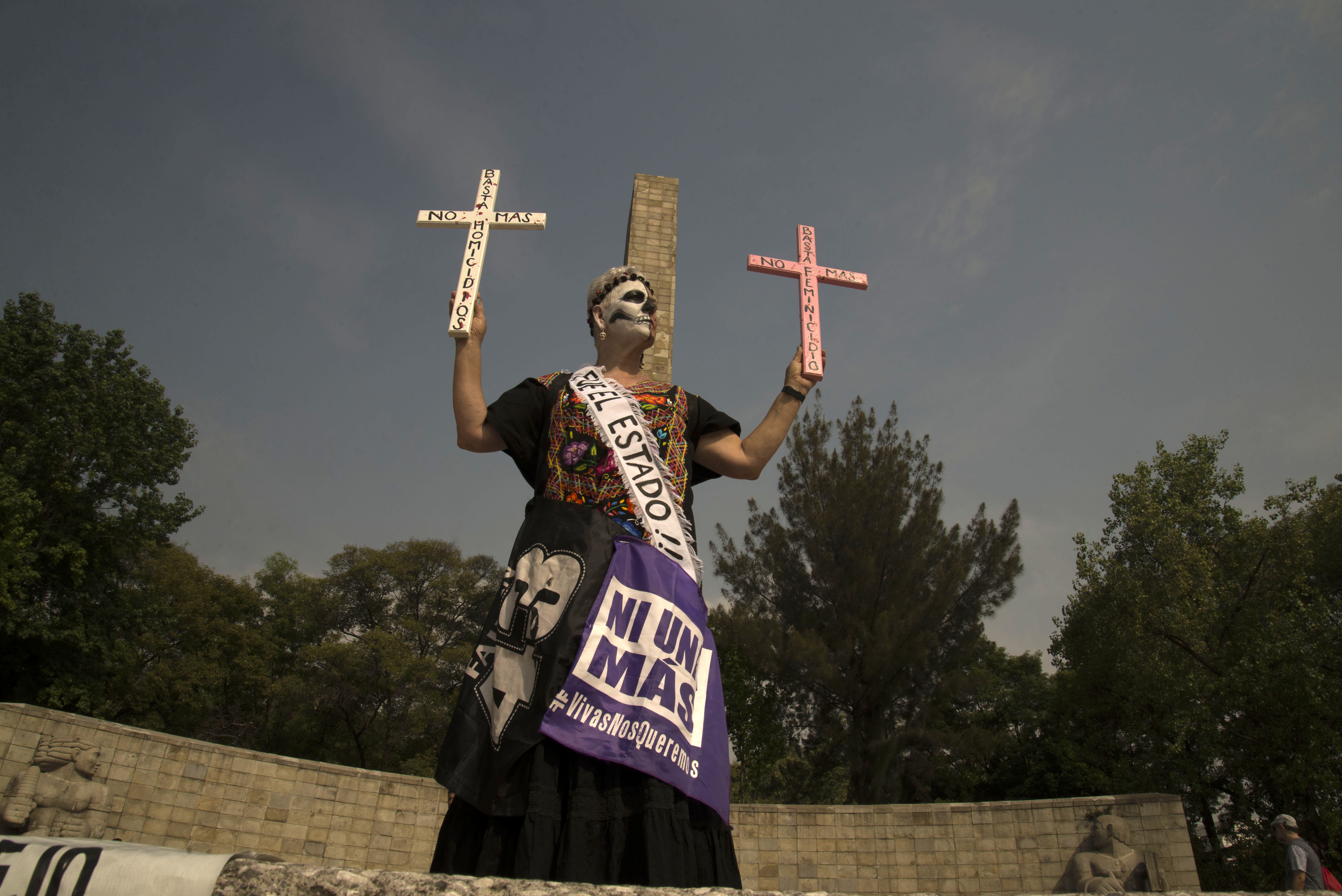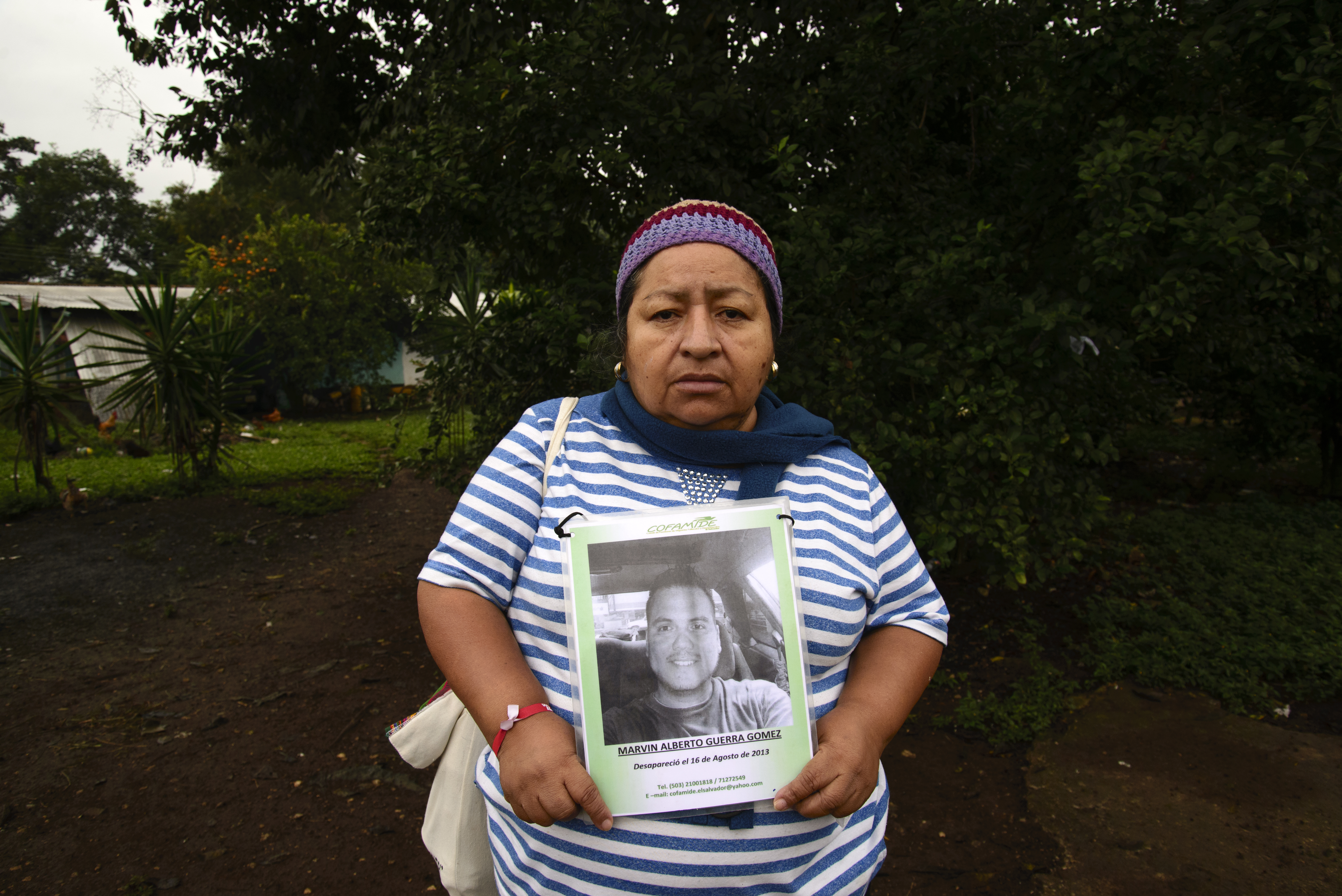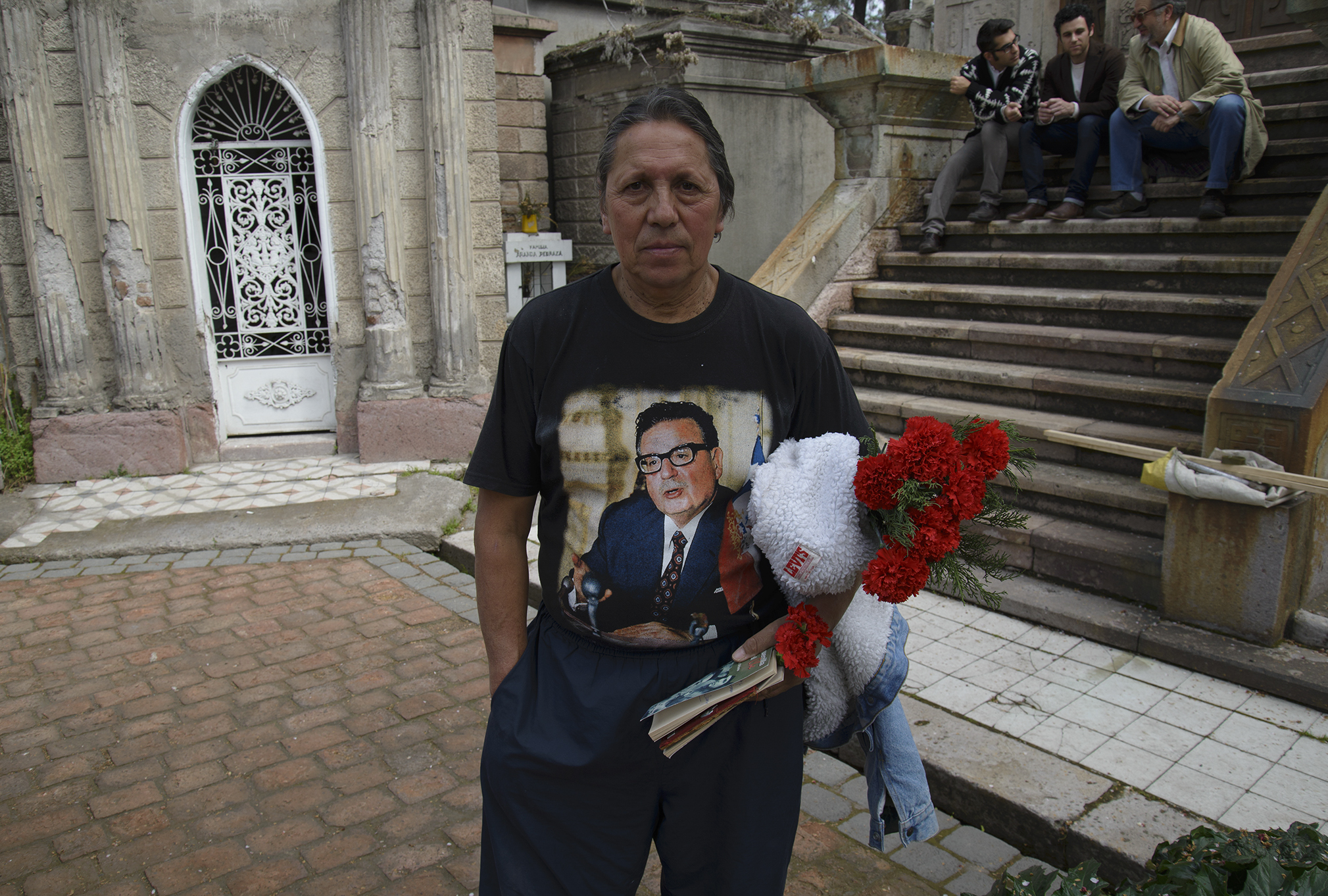
Peregrinos
Chimalhuácan
Estado de México, 2023
La gran peregrinación a la
Basílica de Guadalupe congrega
a millones de fieles que comienzan
su andar desde diferentes partes de México,
solo para observar, por un momento,
a la Virgencita de Guadalupe,
y pedir su bendición.
En el icónico Cerro del Tepeyac,
los evangelizadores españoles introdujeron
la imagen de la Virgen de Guadalupe
y desde entonces le ha sido dado
el título de Tonantzin, "nuestra Madrecita."
En paeriferia de la ciudad,
la gente de los barrios del Oriente
del Estado de México son los primeros
peregrinos que aparecen, realizando
una travesía de aproximadamente
cuatro a seis horas, sorteando
caminos y obstáculos. Llegan
puntuales al santuario de la Morenita,
le cantan sus mañanitas, e imploran
por sus favores y bendiciones.
︎
Les pèlerinages au Mexique Chimalhuácan
Estado de México, 2023
La gran peregrinación a la
Basílica de Guadalupe congrega
a millones de fieles que comienzan
su andar desde diferentes partes de México,
solo para observar, por un momento,
a la Virgencita de Guadalupe,
y pedir su bendición.
En el icónico Cerro del Tepeyac,
los evangelizadores españoles introdujeron
la imagen de la Virgen de Guadalupe
y desde entonces le ha sido dado
el título de Tonantzin, "nuestra Madrecita."
En paeriferia de la ciudad,
la gente de los barrios del Oriente
del Estado de México son los primeros
peregrinos que aparecen, realizando
una travesía de aproximadamente
cuatro a seis horas, sorteando
caminos y obstáculos. Llegan
puntuales al santuario de la Morenita,
le cantan sus mañanitas, e imploran
por sus favores y bendiciones.
︎
remontent à l'époque préhispanique.
En particulier, le grand pèlerinage
à la basilique de Guadalupe rassemble
des millions de fidèles qui commencent
leur voyage depuis différentes régions du pays,
juste pour regarder, pendant un moment,
la Vierge de Guadalupe et lui demander sa bénédiction.
Sur l'emblématique Cerro de Tepeyac,
les peuple indigènes de la vallée du Mexique
se rendaient autrefois en pèlerinage
depuis leurs différents villages pour vénérer
Tonantzin, « notre petite mère ».
Les évangélistes espagnols, après la conquête,
ont remplacé cette divinité par l'image
de la Vierge Marie. Malgré cela, le grand
pèlerinage vers le sanctuaire s'est
poursuivi et s'est maintenu
jusqu'à aujourd'hui.
Les habitants des quartiers
orientaux de l'État du Mexique,
Chimalhuacán -- Nezahualcóyotl, Texcoco,
Chalco, entre autres -- sont les premiers
pèlerins à apparaître, effectuant un
voyage d'environ quatre à six heures,
surmontant routes et obstacles, afin d'arriver
à temps au sanctuaire de la Morenita pour
lui chanter ses mañanitas et lui implorer
ses faveurs et ses bénédictions.

Ofrendas
Camino del Wixárika
San Luis Potosí, 2018
Ahí, regresas del altiplano, despierto.
El desierto te recibe, un sol macerado te ilumina. Vas a regresar, lo sabes. Los tuyos lo van caminar, un día van a regresar. Te da sentido, te ayuda a entender,
lo que sabes, lo que falta por aprender.
Ahí, escuchas los latidos del tambor.
Das gracias por los que te han cuidado. El señor del
temazcal dice que la medicina está en la tierra, un privilegio haber estado en este mundo. El horizonte te trae la mañana. Esta tierra te recibe. Los guardianes retienen lo pasado, saben la forma de lo futuro, esto es lo que dice tu corazón. Alcanzas al cuidador en la milpa. Mira, te dice, el maíz brota sin agua, nace de tierra seca.
En el círculo, el copalito te envuelve,
las lágrimas te refrescan. Has caminado solo lo
que has tenido que caminar.
Ahí, pides por todos los que están
y por los que no podrán estar.
︎
Camino del Wixárika
San Luis Potosí, 2018
Ahí, regresas del altiplano, despierto.
El desierto te recibe, un sol macerado te ilumina. Vas a regresar, lo sabes. Los tuyos lo van caminar, un día van a regresar. Te da sentido, te ayuda a entender,
lo que sabes, lo que falta por aprender.
Ahí, escuchas los latidos del tambor.
Das gracias por los que te han cuidado. El señor del
temazcal dice que la medicina está en la tierra, un privilegio haber estado en este mundo. El horizonte te trae la mañana. Esta tierra te recibe. Los guardianes retienen lo pasado, saben la forma de lo futuro, esto es lo que dice tu corazón. Alcanzas al cuidador en la milpa. Mira, te dice, el maíz brota sin agua, nace de tierra seca.
En el círculo, el copalito te envuelve,
las lágrimas te refrescan. Has caminado solo lo
que has tenido que caminar.
Ahí, pides por todos los que están
y por los que no podrán estar.
︎
.

Mother’s Day
Monumento a la Madre
Mexico City, 2017
In the morning, a song percolated through the crowd. It swifted in the air, the words lingered, “Aunque sea en una tumba, quiero verte,” (Even if it’s in a tomb, I want to see you). Gregoria Ortiz Garnica fought back tears and stared at the sun, a photo of her son, Gustavo, in her hands. The boy disappeared in 2007 at the age of 12, on his way home from school, in the city of Pachuca.
“We have dedicated ourselves to this task of finding him,” Ortiz said. “But ten years have passed and we haven’t been able to find out what happened.”
The boy is one of more than 27,000 people to have vanished in Mexico since 2006. On Mother’s Day, the families of the disappeared marched through the streets — down Paseo de la Reforma, to the Ángel de la Independencia monument — a river of photographs of the missing flowing through the heart of the city.
Gustavo Alberto de la Cruz, who has been gone for a decade now, would have turned 22 in 2017. His mother thinks of him every day. She wants him to know that she is looking for him, that she, too, will not stop until she finds him.
“When I think of him,” she said, “I think of him married, with children, and that one day he is going to return.”
Above, a woman stands underneath Monumento a la Madre (Monument to the Mother), a towering statue of a woman embracing her child, on Mother’s Day. The signon her skirt reads “Ni una más” (Not one more).
︎
Monumento a la Madre
Mexico City, 2017
In the morning, a song percolated through the crowd. It swifted in the air, the words lingered, “Aunque sea en una tumba, quiero verte,” (Even if it’s in a tomb, I want to see you). Gregoria Ortiz Garnica fought back tears and stared at the sun, a photo of her son, Gustavo, in her hands. The boy disappeared in 2007 at the age of 12, on his way home from school, in the city of Pachuca.
“We have dedicated ourselves to this task of finding him,” Ortiz said. “But ten years have passed and we haven’t been able to find out what happened.”
The boy is one of more than 27,000 people to have vanished in Mexico since 2006. On Mother’s Day, the families of the disappeared marched through the streets — down Paseo de la Reforma, to the Ángel de la Independencia monument — a river of photographs of the missing flowing through the heart of the city.
Gustavo Alberto de la Cruz, who has been gone for a decade now, would have turned 22 in 2017. His mother thinks of him every day. She wants him to know that she is looking for him, that she, too, will not stop until she finds him.
“When I think of him,” she said, “I think of him married, with children, and that one day he is going to return.”
Above, a woman stands underneath Monumento a la Madre (Monument to the Mother), a towering statue of a woman embracing her child, on Mother’s Day. The signon her skirt reads “Ni una más” (Not one more).
︎
 .
.
Ana Claribel
Amatlan de los Reyes
Veracruz, 2015
Although no official figures exist, it is thought that at least 70,000 migrants and refugees have gone missing in Mexico since 2006. By the summer of 2015, more than 60 million people around the globe had been forced from their homes as a result of persecution, conflict, or violence.
In late 2015, Ana Claribel Mendoza (pictured), from El Salvador, toured parts of Mexico looking for her son, Marvin Alberto, who disappeared in 2013, on his way to the United States. She was one of roughly 40 Central American mothers who visited prisons, shelters, as well as other spots along the migrant route, looking for missing sons and daughters.
“It is women who suffer the most,” Mendoza said. “When someone leaves, they leave a mother, a grandmother, or a wife, with the kids, and we’re the ones who have to struggle alone. I tell you that this pain turns into anger when we have to look for the ones that have gone missing.”
︎
Amatlan de los Reyes
Veracruz, 2015
Although no official figures exist, it is thought that at least 70,000 migrants and refugees have gone missing in Mexico since 2006. By the summer of 2015, more than 60 million people around the globe had been forced from their homes as a result of persecution, conflict, or violence.
In late 2015, Ana Claribel Mendoza (pictured), from El Salvador, toured parts of Mexico looking for her son, Marvin Alberto, who disappeared in 2013, on his way to the United States. She was one of roughly 40 Central American mothers who visited prisons, shelters, as well as other spots along the migrant route, looking for missing sons and daughters.
“It is women who suffer the most,” Mendoza said. “When someone leaves, they leave a mother, a grandmother, or a wife, with the kids, and we’re the ones who have to struggle alone. I tell you that this pain turns into anger when we have to look for the ones that have gone missing.”
︎

Aniversario
Mausoleo de Salvador Allende
Cementerio General
Santiago, 2013
With marches, plays, exhibits and performances, tens of thousands of Chileans marked the 40th anniversary of the coup that ended the presidency of Salvador Allende and ushered in the dictatorship of Gen. Augusto Pinochet. The day, Sept. 11, 1973, is commemorated every year, in Chile, as the original 9/11, a day of national infamy.
In 2013, the coup was remembered with renewed calls to bring to justice those responsible for Pinochet’s seventeen-year reign. According to government figures, Pinochet imprisoned, tortured, exiled, abducted, or killed nearly 40,000 people.
To this day, the challenge for hundreds of Chileans lies in finding the remains of more than 1,000 people, who were forcibly disappeared during the dictatorship.
Above, a man brings flowers to the Allende’s grave, one autumn morning, just days before the anniversary.
Photographie
Federico Barahona
︎
︎
© 2015-2023
All rights reserved
[ l i g n e s n o i r e s ]
Mausoleo de Salvador Allende
Cementerio General
Santiago, 2013
With marches, plays, exhibits and performances, tens of thousands of Chileans marked the 40th anniversary of the coup that ended the presidency of Salvador Allende and ushered in the dictatorship of Gen. Augusto Pinochet. The day, Sept. 11, 1973, is commemorated every year, in Chile, as the original 9/11, a day of national infamy.
In 2013, the coup was remembered with renewed calls to bring to justice those responsible for Pinochet’s seventeen-year reign. According to government figures, Pinochet imprisoned, tortured, exiled, abducted, or killed nearly 40,000 people.
To this day, the challenge for hundreds of Chileans lies in finding the remains of more than 1,000 people, who were forcibly disappeared during the dictatorship.
Above, a man brings flowers to the Allende’s grave, one autumn morning, just days before the anniversary.
Photographie
Federico Barahona
︎
︎
© 2015-2023
All rights reserved
[ l i g n e s n o i r e s ]